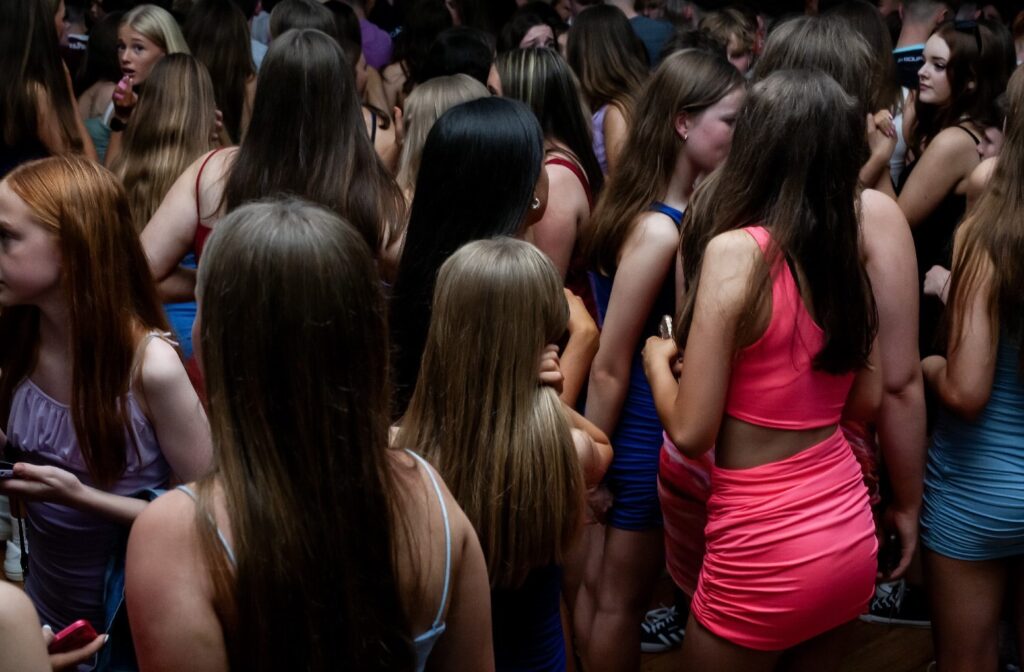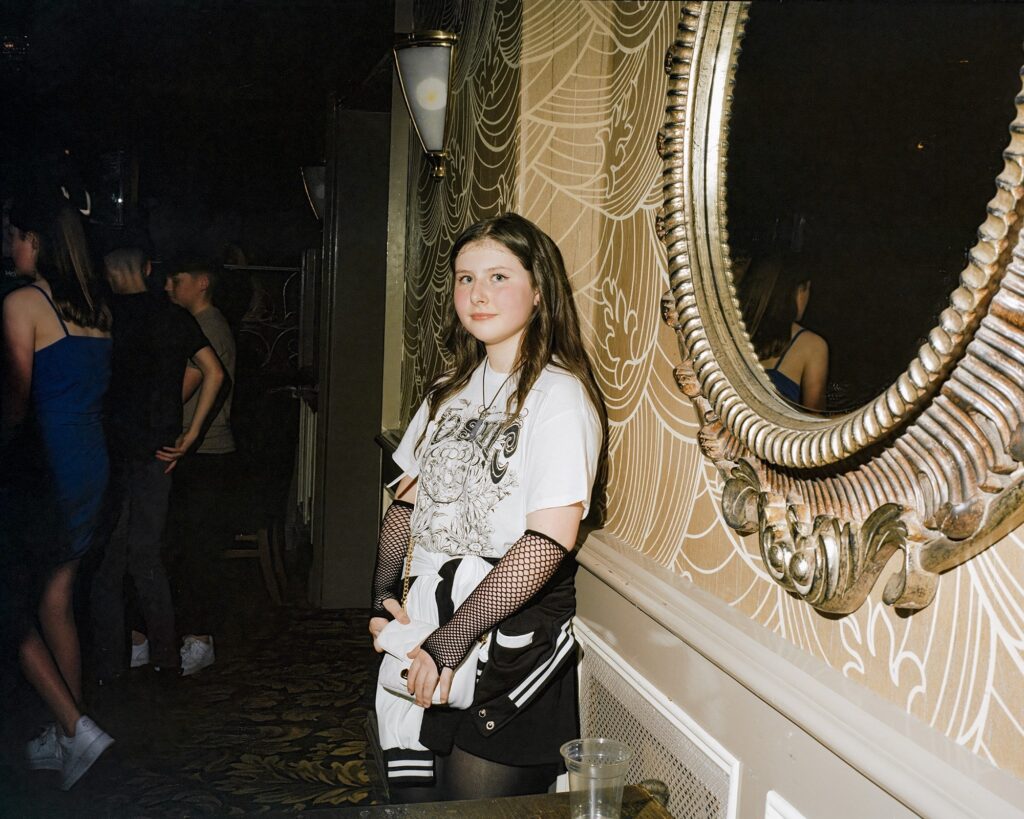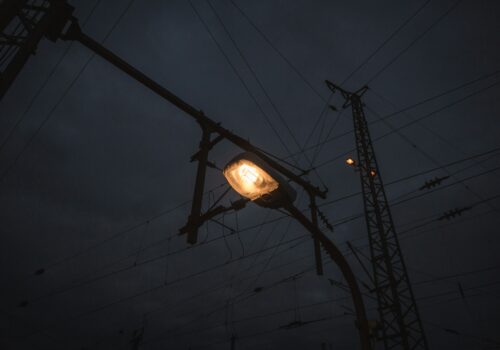Eimear Lynch’s Girls’ Night Documents Irish Girlhood
Words: Izzy Copestake
Photography: Eimear Lynch’s Girls’ Night – IDEA
In her new photo book Girls’ Night, Eimear Lynch archives the nervous anticipation, female friendship, and full-glam inherent in the preparation for teen discos across Ireland.
Flicking through the pages of Girls’ Night, early adolescent getting-ready rituals awaken from picture to picture. From pin-straight hair and the sizzle of a straightener cranked up to full heat, to hours spent swapping huge eyeshadow palettes and polyester body-con dresses, the intimate world Lynch has captured is one that will be familiar to many women, especially those accustomed with the exhilarating process of prepping for a teen disco in Ireland.

Taking inspiration from Andrea Arnold films and Lauren Greenfield’s Girl Culture, Lynch has inserted her work into a tradition of capturing female coming of age moments, placing her alongside photographers such as Petra Collins and Abigail Heyman, who’ve archived coming of age moments internationally.
Yet Lynch has not just captured universal rites of passage, such as the joy of female friendship and the early performance of what teens expect womanhood to be, but a youth culture which is inherently unique to Ireland. From the intimate spaces of bathrooms and bedrooms, to the dance floors filled with girls dancing in Shein dresses and boys shuffling the perimeter, Girls’ Night tells a story of how Ireland’s teen discos serve as important and chaotic stages for girlhood milestones to take place.
We chatted to Eimear Lynch about the launch of the new book, navigating such intimate spaces, and screaming along to Olivia Rodrigo on the way to teen discos.

What inspired you to start documenting this rite of passage in Ireland?
I just have such fond memories of that time. That period of my life, going to teen discos, was such a nice and happy time. I think that what came after, as being a teenager, when you’re 16 – 17, that’s when things kind of got a bit more complicated.
But that, 13-14 year old, is quite a sweet spot where you’re just so excited to grow up. You’re so excited to finally wear a bodycon dress and wear makeup for the first time and life is just so simple and it hasn’t been complicated yet. Everything’s just fun and exciting. So I wanted to just document that excitement, and relive my time of going to teen discos through this book.
“I wanted to just document that excitement, and relive my time of going to teen discos through this book. “
Eimear Lynch

You said your own experience was pretty positive, do you think much has changed?
I think it is still quite positive. I look back on it now, and I have very positive memories, but in reality, now that I’m thinking about it, it probably wasn’t that great. I was drinking loads, I got sent home from one, but I don’t think people now drink.
So I think it is a bit more fun now. I think that getting ready for it is just a good excuse to hang out with your friends and to kind of perform as a woman together for the first time in your life. You know, going from being a child to then acting like a woman. I just think that’s such a fun thing to be able to do with your friends.

So this is a performance of imagined womanhood, in a way?
People have been asking me about the photos in the book of people wearing the same dress and stuff and I don’t think it’s even that people are doing it because they want to fit in. I think they have literally just been a child last year, and they think that’s what you do as you grow up. You just put on this bodycon dress, and that represents the stage of your life.

How do you think teen discos play a role in hitting adolescent landmarks?
There’s so much kissing. I think that still plays such a central part in going to teen discos. It’s still the exact same as when I went: Will you kiss my mate? Everyone tries to get a kiss. That’s definitely still the same. But drinking is not a big thing. No one was as messy as me and my friends were at that age. Everyone was vaping though.
“It’s still the exact same as when I went: Will you kiss my mate?“
Eimear Lynch

In your birds-eye shot of the dance floor, it looked like there were lots of boys on one side and girls on the other, is there generally much segregation at the discos themselves?
Definitely during the first hour of the night. Everyone’s on completely different sides, no one’s talking to each other. Everyone’s so anxious and nervous. The boys didn’t really dance, but after the first hour it loosens up when people mix.

Often personal projects reveal something about their maker. What were the key themes that you saw manifesting in your subjects that really resonated with your own experiences as a young woman?
The female friendship aspect of it was something that I really wanted to capture. That’s something that I really loved about that time of my life. The girlfriends from school were the most important people to me and we would get ready for five or six hours together, just for fun. We didn’t actually spend all that time doing hair and makeup, but we would just slowly do it, and it becomes an excuse to hang out. So that was kind of something that I really valued and wanted to portray in this book.
“I was really fascinated with shooting the girls that were outside groups”
Eimear Lynch
Some of the photos have portraits of girls by themselves or girls kind of on the outside of the group. I was really fascinated with shooting the girls that were outside groups, and who were just having moments by themselves. I don’t feel like I was that person when I was going to discos, I was very much trying to be around my friends and stuff. But I think that’s kind of who I am now. I’d not like to be the centre of attention, and more try to be the person on the outside. I like to have quiet moments. So I found it really interesting watching girls do that.
And I have one photo of a girl whose wearing fishnet gloves, and a baggy t-shirt. Everyone else is in a bodycon dress, and she just looks really comfortable in herself. I just really loved that photo.

The ‘full glam’ is obviously a huge part of the adolescent getting ready rituals in Ireland, why do you think this is something which has kept on unifying teenage girls in Ireland year after year?
The trend in Ireland is to wear fake tan and wear makeup. I think so many young girls are terrified of their pale skin and their freckles. They don’t appreciate the Irish look and they want to look like the people they see online, tanned and with loads of makeup. As a teenager putting on the makeup and the eyelashes and stuff is a bit of fun, you want to show off your makeup skills.
“I think so many young girls are terrified of their pale skin and their freckles.”
Eimear Lynch
Did the getting-ready rituals differ from county to county?
So they’re mainly the same. Everyone wore a dress from Shein in different colours and they’d swap them around, and then they’d wear runners Converse or Nikes. There was one disco that I photographed them to where everyone wore GAA jerseys and GAA shorts, which is so weird, and I don’t know why they were wearing that. I thought it might have been a jersey night or something, but it wasn’t, so that was just the style there.

What did the girls chat about?
Most of the time they were so confident. They’d talk about boys, but not in an obsessed way. More so they would talk about them as if they had them wrapped around their fingers. They were so in control, they’re confidence was amazing.
So when I was photographing them they were hanging out together, so I literally could barely even get a word in. They were just chatting so much. They were all talking about the same things: music TikToks, makeup. I was kind of surprised at how into music some of the girls were. I feel like I was just only listening to whatever was in the charts. Whereas people have cool music tastes now maybe that comes from the Internet.
“They were so in control, they’re confidence was amazing.”
Eimear Lynch

What was it like negotiating access to such intimate environments?
It was pretty hard, It took a long time. I kind of did one group that I found pretty easily. I was living in Paris at the time, and I’d photographed them when I was back in Ireland and decided to move back to Ireland for the book. But it took months before I did another photoshoot.
I found this agency and they helped me a lot with finding people. They did call outs on their instagram, which kind of made it a lot more legit, instead of me being unknown and trying to reach out to people. Once I did a couple of shoots, it got, a lot easier because I was able to show parents the exact photos that I was going to take. At the start, it was really, really long. People don’t really understand photo books generally as well. They didn’t really understand what it was for.

What kind of concerns did you have before starting the project, in terms of working with young people at such a vulnerable age?
Well, I knew what I wanted to include and what I didn’t want to include. I didn’t want to include anything that would make anyone insecure or something that they would regret having published. I didn’t want to include any photos of anyone kissing or any photos that aren’t flattering or any kind of embarrassing photos or anything.
I didn’t want anyone to kind of regret giving me access. I knew it was a very I was very lucky to actually be invited into people’s bedrooms, so I didn’t want to take advantage. I would speak to the girls at the start and just say: I’m just going to keep taking photos and I’ll send you all the photos and if there’s anything you don’t like and I won’t use. Because I also wanted to make them comfortable with me just snapping away, instead of them feeling like they needed to pose all the time.
“I didn’t want to include anything that would make anyone insecure or something that they would regret having published.”
Eimear Lynch

Initially, did the girls try to pose a lot?
I think they just didn’t really know what they were supposed to do. When I had the camera out, they didn’t know if they should turn and smile. So I said: just pretend I’m not here.
When I was in the girls’ bedrooms, they actually warmed up to me really quickly. It would take about 10 or 15 minutes. To begin with, they’d be like: Who’s this weirdo in my room? And then after a while they really just forgot I was there. They were all talking to each other anyway. They had to do their hair and makeup, there was a big night ahead of them.
“To begin with, they’d be like: Who’s this weirdo in my room? “
Eimear Lynch

Have the girls seen the book, what were their reactions like?
So most of the girls have seen it. They seem to really like it. I think they’re excited. Simone Rosha shared one of the photos of one of the girls, and she was really excited about that.

Simone Rocha hosted your London launch party. Did you guys chat much about he shared experience of Irish girlhood and adolescence?
Yeah. I mean, she’s kind of had the same experience pretty much. That’s why I wanted to ask her to do the forward, because I think people kind of forget that she is such a normal Irish girl. Despite how successful she is now, she grew up pretty much the same as everyone else in Ireland. She went to discos, and did the exact same things that I did and that people still do now.
I think you see that element of girlhood in (Simone Rocha’s) work, and also in your photos, so that collaboration feels perfect.
That’s what I love about her work is that it’s so girly, and it allows girls to be really girly. There’s not many brands that just celebrate girls. She’s such a good fit for this because the world that she creates is so lovely and girly. But it’s also very dynamic: it’s dark and light at the same time. It captures the reality of being a girl.
“There’s not many brands that just celebrate girls.”
Eimear Lynch

Were there any particular sources which were of inspiration when making this book?
I watched a lot of films, Andrea Arnold films in particular. She does a lot of stuff about girlhood. There’s a book called Girl Culture by an American photographer called Lauren Greenfield who documented teenage girls in the nineties. I was in Ireland at the time, and my photo books were in storage in London. So the only book that I had Girl Culture that I had back in Ireland, so I was using that a lot for inspiration. I listened to loads of Olivia Rodrigo to try to get into the teen spirit.
I kind of started listening to her thinking: I need to listen to what teenage girls listen to now, and then I became completely obsessed with her and would just scream along in the car on the way to discos.
“I listened to loads of Olivia Rodrigo to try to get into the teen spirit.”
Eimear Lynch

Do you think the teen disco phenomenon is an evolved form of traditional céilí and 50s / 60s dance culture?
I suppose they have just evolved from the other. It is still just a meeting place for people around the area to meet up and see each other. So I suppose that is why they’re so big in Ireland, it is similar to céilí culture. They’ve just kind of advanced in the style of the music. The two are very similar and that they’re very community based. A lot of them will be in sports halls for community centres. They definitely would be quite similar in that they bring communities together.
Eimear Lynch’s Girls’ Night is available at IDEA






